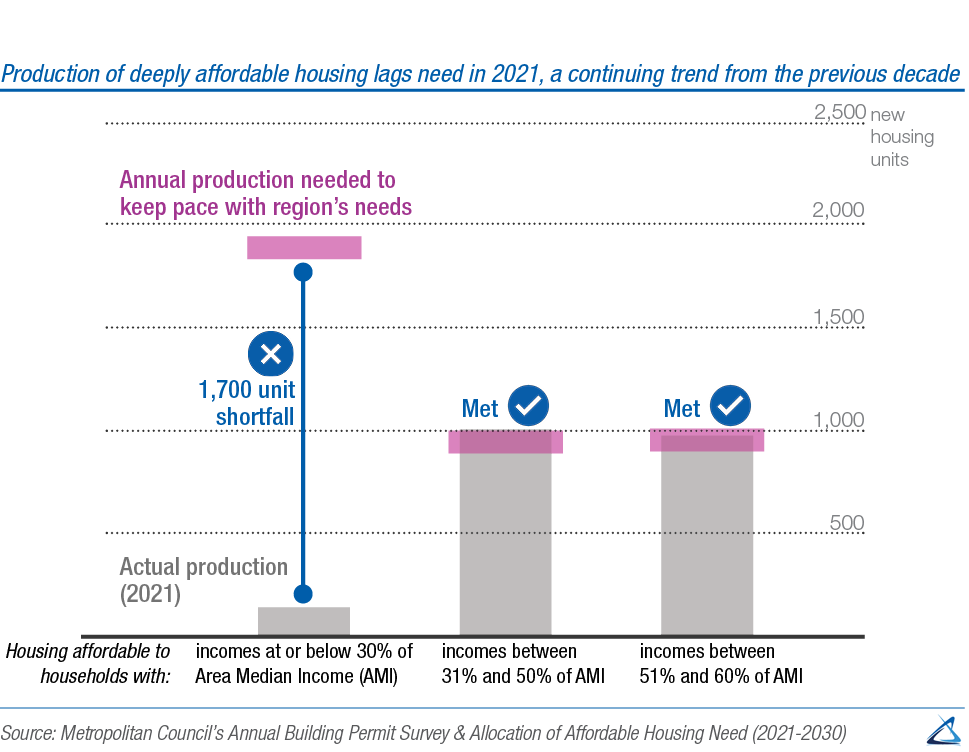The Metropolitan Council will conduct a study to measure the cost of inaction on affordable housing in 2023. The study will investigate how much it costs to offer services like education, food, healthcare, and childcare — the costs of living a stable life beyond housing for those with very low incomes. Governmental agencies in other states, including Massachusetts and Utah, have pursued similar research.
“So many issues stem from housing instability, like employment loss, minimal access to healthcare and medications, among many others,” said Hilary Lovelace, senior planner for Livable Communities at the Met Council.
Many cities are facing an affordable housing crisis, and it’s impacting renters and potential homeowners the most. Minimum wages and area median incomes are not keeping up with rents and median-priced homes, making it difficult for people to cover the other basic costs of living.
2021: another big gap in production of housing affordable to lowest income households

Our region has a significant gap between the need for deeply affordable housing and what is available. Evidence of this includes the increase in people sleeping in tents and signing at intersections. This is only the tip of the iceberg: the region has 156,000 households with extremely low-incomes — many with a full-time worker. If you’ve travelled to almost any major metropolitan areas pre- or post-pandemic, you may have noticed that this growing need of deeply affordable housing is not unique to Minnesota.
According to Joel Nyhus, Met Council researcher, “In 2021, we saw some positive news: the 2021 production of housing for households between 31% and 60% of area median income met forecasted needs. Unfortunately, we also saw a production gap of 1,700 units for housing with rents at or below what is affordable to households earning 30% of area median income.” This gap is not new and worsens a longstanding problem.
Building affordable housing is "not lucrative"
So, why is there such a shortage of deeply affordable housing?
“It’s not a lack of awareness or effort,” Lovelace stated. “I’ve seen good effort happening among Met Council, city, and county government partners. Systematic barriers are at play here, and developers and financial institutions have a lot of power in the market.
“It’s not lucrative to build housing with units at 30% area median income, and many affordable housing developers struggle to break even when building a development with more than just a few units affordable at 30% AMI,” Lovelace said. “When we see this big of a gap between forecasted need and actual production, it is a call to think differently about how to incentivize these types of developments to meet the need in our region.”
Lovelace is one of the authors of the upcoming 2050 Housing Policy Plan. “The study on the risk of inaction will help lay out the narrative to build the policy foundation for the 2050 Housing Policy Plan,” she said. “We want to talk about affordability in a way that better reflects the reality of residents and households with low incomes in our region.”
Met Council role in affordable housing
The Met Council has several roles related to affordable housing:
- We set housing policy direction for the seven-county region.
- We work with local governments to identify and plan for their future housing needs, and review the housing element of local comprehensive plans.
- We provide grant funding for development and preservation projects of rental units affordable to households with 80% area median income or less through the Livable Communities Act programs.
- Metro HRA, our housing and redevelopment authority, assists more than 7,200 households monthly to obtain decent and affordable housing through the private rental market in nearly 100 cities in Anoka, Carver, and most of suburban Hennepin and Ramsey counties.